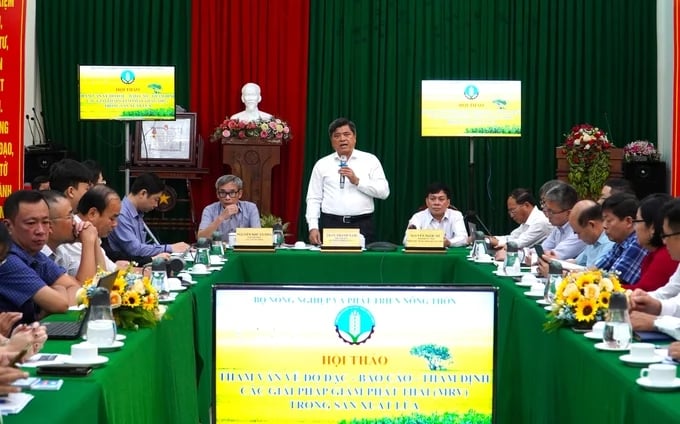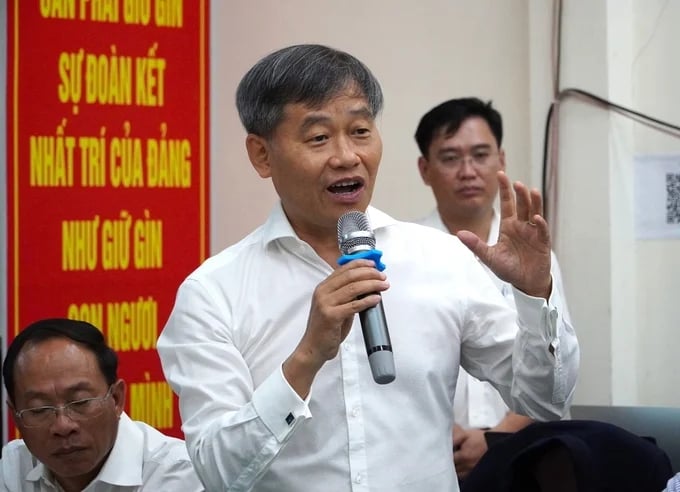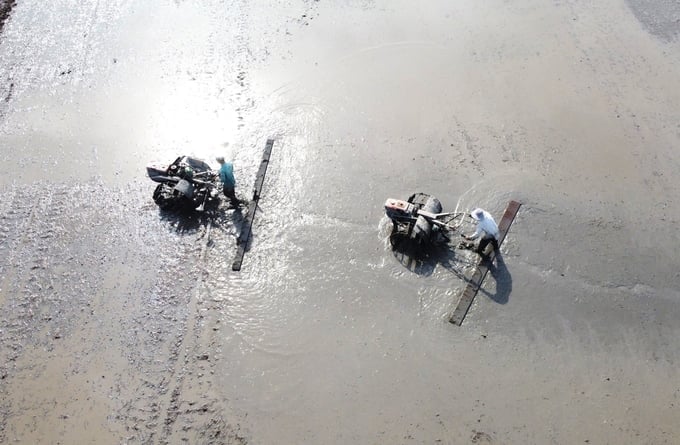June 20, 2025 | 06:59 GMT +7
June 20, 2025 | 06:59 GMT +7
Hotline: 0913.378.918
June 20, 2025 | 06:59 GMT +7
Hotline: 0913.378.918
On March 20, in Can Tho City, the Department of Crop Production (Ministry of Agriculture and Rural Development) organized a consultation workshop on measurement - reporting - appraisal of Measurement, Reporting, and Verification of Carbon Removal (MRV) in rice production.
This activity collects opinions from international organizations and experts on the plan to measure, report, and evaluate emissions according to the Sustainable Development Project of 1 million hectares specializing in high-quality rice cultivation and emissions. associated with green growth in the Mekong Delta until 2030 (1 million hectares of high-quality rice project), chaired by Deputy Minister of Agriculture and Rural Development Tran Thanh Nam.

Deputy Minister of Agriculture and Rural Development Tran Thanh Nam chaired a workshop to collect opinions from experts and international organizations on Measurement, Reporting, and Verification of Carbon Removal (MRV) in rice production in rice production. Photo: Kim Anh.
The MRV system is the technical and procedural steps to measure, report, and appraise greenhouse gas emissions. This is the basis for granting carbon credits to areas that have applied low-emission rice farming processes. Aiming at the domestic and foreign carbon credit market, contributing to increasing income for farmers and enhancing the added value of rice products.
To build a planning framework for the MRV method, recently the Ministry of Agriculture and Rural Development has assigned affiliated units, with the focus being the Institute of Agricultural Environment to coordinate with the Department of Crop Production to research and plan. At the same time, consult with many domestic and international experts. From there, the implementation rules will be agreed upon, and comments will be collected for improvement before officially working with the Transitional Carbon Asset Finance (TCAF) fund.
Accordingly, valid emissions reduction activities in the MRV method of the Ministry of Agriculture and Rural Development and TCAF are based on many factors: Season and growth stages of rice plants; Rice is not flooded more than 180 days or less than 180 days before the crop; flooded more than 30 days before the crop; Withdraw water once in the middle of the crop, alternate wet and dry irrigation to withdraw water many times; Bury fresh straw within 30 days before the crop.

The MRV system is the technical and procedural steps to measure, report, and appraise greenhouse gas emissions. Photo: Kim Anh.
According to the planning framework for implementing this MRV method, activities will be carried out in the 2024 - 2025 period to confirm water withdrawals, monitor water levels, take analytical samples, calibrate models, simulate, and correlate satellite images with measurement results.
By the 2026 - 2030 period, satellite images will be processed (confirmation of CH4 depletion/measurement), machine learning, calculation and confirmation of emission reduction levels, and progress to carbon credit confirmation.
At this event, many international organizations introduced outstanding MRV methods that have been successfully applied in many countries around the world. Typically, the MRV capacity for rice of Regrow Organization or MRV solutions for AWD (Technology to save water for irrigation in rice fields without reducing productivity) of Thanks Carbon's.
With the above solutions, diversity in ways to measure MRV has been created. However, according to a senior expert from the World Bank - Mr. Cao Thang Binh needs to create consensus and unify the criteria when implementing on a large scale, to promote the effectiveness of the Project.

Mr. Cao Thang Binh, senior expert at the World Bank (WB), said that the MRV method of the Ministry of Agriculture and Rural Development will create consensus and uniformity on criteria when deployed on a large scale. Photo: Kim Anh.
In particular, the MRV method deployed by the Ministry of Agriculture and Rural Development will create a basis for transfer throughout the agricultural sector system from central to local levels, with long-term reception. Thus creating sustainability for the 1 million hectares of high-quality rice.
Mr. Binh also emphasized that the 1 million hectares of high-quality rice project is a program of the Vietnamese Government with many participating partners. In particular, the World Bank is one of the first accompanying partners. However, that does not mean it is the only unit; currently, the WB's capital mainly focuses on infrastructure.
The initiatives of participating international organizations demonstrate that the project has received strong diffusion. However, it should be noted that the technical criteria for people to apply uniformly facilitate the direction of the Ministry of Agriculture and Rural Development.

When implementing the MRV method in the Mekong Delta, small production households must be attached to cooperatives for a support mechanism. Photo: Kim Anh.
To effectively implement the above orientations, the leader of the Ministry of Agriculture and Rural Development, Deputy Minister Tran Thanh Nam welcomed and called on international organizations to participate in developing 1 million hectares of high-quality rice in the Mekong Delta. The Ministry of Agriculture and Rural Development respects the MRV plans of international organizations. However, the issue that the Deputy Minister assessed needs to be agreed upon by the parties in compliance with Vietnam's management mechanism.
According to the Deputy Minister, it is possible to coordinate the MRV method so that many organizations can participate in the 1 million hectares of high-quality rice project. However, it is necessary to comply with the directions of the Ministry of Agriculture and Rural Development to avoid competition problems in the payment of carbon credits in the Mekong Delta region.
The difficulty of implementing the MRV method in the Mekong Delta today is that the area is fragmented, so small production households must be attached to cooperatives to have a support mechanism; Especially calling for the participation of businesses in building large-scale raw material areas of several hundred to several thousand hectares.
The World Bank determined that the 1 million hectares of high-quality rice project is a key project in the Asia-Pacific region and committed to being ready to exchange carbon credits with the project.
Translated by Tuan Huy
![Turning wind and rain into action: [9] Digitizing hydrometeorological data in response to climate change](https://t.ex-cdn.com/nongnghiepmoitruong.vn/608w/files/news/2025/06/17/z6704423696987_15fd32ffc26d590d204d520c9dac6786-nongnghiep-165943.jpg)
(VAN) Farmers have begun accessing hydrometeorological applications to adjust their cropping schedules, aiming to ensure productivity and adapt to climate change.
![Turning wind and rain into action: [8] Real-time salinity detection and early warning technology](https://t.ex-cdn.com/nongnghiepmoitruong.vn/608w/files/news/2025/06/17/z6704423696987_15fd32ffc26d590d204d520c9dac6786-nongnghiep-151127.jpg)
(VAN) Thanks to the integration of modern hydrological-hydraulic models, remote sensing technologies, and artificial intelligence, the accuracy of hydrological forecasting has significantly improved.
![Turning wind and rain into action: [7] Early disaster warnings help marine farmers minimize losses](https://t.ex-cdn.com/nongnghiepmoitruong.vn/608w/files/news/2025/06/17/z6704423696987_15fd32ffc26d590d204d520c9dac6786-nongnghiep-142942.jpg)
(VAN) In recent years, thanks to early disaster warnings and forecasting, marine farmers in Khanh Hoa province have been able to reduce risks and losses, thereby improving production efficiency.
![Turning wind and rain into action: [6] ‘Four on-the-spot’ disaster management software](https://t.ex-cdn.com/nongnghiepmoitruong.vn/608w/files/news/2025/06/17/e5a48259d6a262fc3bb3-nongnghiep-183800.jpg)
(VAN) By simply activating the scenario on the disaster management software, the relevant authorities immediately know how many households need to be evacuated, where to evacuate them to, and by what means of transportation…
![Turning wind and rain into action: [5] Hue applies modern technology in disaster forecasting](https://t.ex-cdn.com/nongnghiepmoitruong.vn/608w/files/news/2025/06/17/z6704423696987_15fd32ffc26d590d204d520c9dac6786-nongnghiep-093938.jpg)
(VAN) In Hue city, modern technology has recently been applied in meteorological and hydrological forecasting and warning, helping to reduce the damage caused by natural disasters.

(VAN) A cutting-edge farming technique being implemented on an experimental ranch in Arizona's Sonoran Desert has already saved a billion gallons of water over five years, according to Civil Eats.

(VAN) Poultry and pig production and the environment can be boosted through enhanced water technology, according to new research.